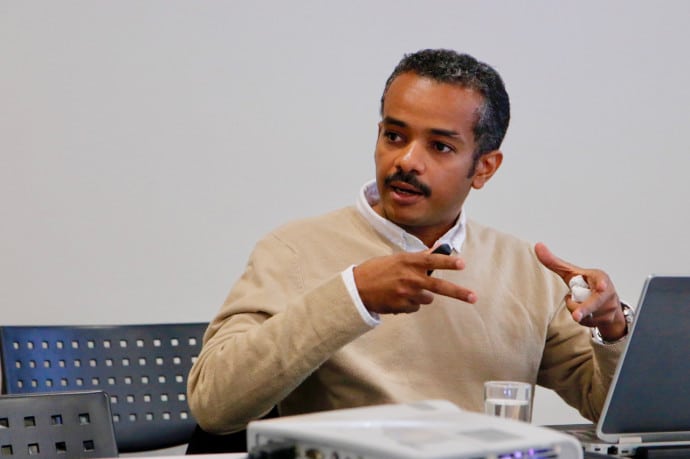“Heart disease remains a major killer with the World Health Organization estimating it will be second to cancers by 2030. It’s clear we need new treatment options,” said Mazin Sirry of the Department of Biomedical Engineering, University of Medical Sciences and Technology, Khartoum, Sudan. Sirry was presenting an overview of the research project he is conducting while at STIAS in which he will use computer modelling to investigate the mechanics of biomaterial injections in hearts damaged by heart attack.

Myocardial infarction, or a heart attack, is a major cause of death globally. The South African Heart and Stroke Foundation estimates that cardiovascular diseases as a whole (including heart disease and strokes) kill 17 million people annually globally and are responsible for almost 1 in 6 deaths in South Africa.
“In ischaemic heart disease there is usually a blockage in the coronary artery – the heart cells without access to blood die off causing irreversible damage,” said Sirry. “This causes loss of contraction in the muscles affecting the pumping action of the heart and causing a heart attack or myocardial infarction. Heart cells do not regenerate so the damaged cells are not replaced thus causing long-term heart failure.”
Current treatments include drug therapy which aims to prevent clotting and reduce heart stress; interventions like the placement of a balloon and stent which dilates the occluded artery and restores blood flow; bypass surgery to replace the damaged artery; the use of mechanical support devices including placing a mesh around the heart to assist in pumping the blood; or heart transplantation.
“Each case has its own needs,” said Sirry, “and you need to choose the best tools.”
“However, for transplantation there is generally a shortage of donors, high cost and risk of transplant failure,” he continued. “It also requires specialised clinics that are not necessarily available on a large scale in low-income settings.”
It’s therefore clear that newer therapies are needed and one option is therapies based on cell-delivery approaches.
“This means injecting immature cells into the affected region to replace the damaged cells. The injection usually includes biomaterials along with the cells and has shown good results in reducing the size of the area damaged by the infarction.”
But the research in this area was not without debate because it wasn’t clear if the results were due to the cells or if the biomaterials alone had an impact.
“A 2006 study demonstrated that cardiac function might potentially be improved just by increasing the thickness of the ventricle wall by the use of biomaterials,” said Sirry. “In 2009 a research group at the University of Cape Town developed a synthetic polyethylene glycol hydrogel which on its own showed good results in preventing the adverse ventricular remodelling.”
“These and other studies showed that cell and biomaterial injection therapy is a new and promising treatment for myocardial infarction. However, it has not yet been fully optimised.”
It became clear that an increased understanding of the mechanical aspects of the heart was needed including understanding the alterations induced by the biomaterial injection at a microscopic level. This is where computational modelling was found to be extremely useful.
Sirry’s research therefore uses computer models to help to understand the underlying mechanical mechanisms and to predict the changes that occur when the gel is injected.
“This gives us important information on the volume, the geometry and shape of the gel within the tissues, the underlying patterns formed and, hopefully also information on the optimal location and timing of the gel injection. We hope to attain a realistic configuration of what happens to the gel once it is injected and how this might optimise treatment.”
“The aim is to understand the micromechanics of a biomaterial injected into an infarcted heart using computer modelling.”
“All previous studies have been at the level of the organ now there is a need to go to the microscopic level to obtain a more detailed model of how the gel configures itself within the heart structure. An infarct leads to huge microscopic changes, you therefore can only understand the positive outcomes of the use of the gels by looking at the microscopic level. Then you translate that information back from the microscopic to the organ level,” continued Sirry.
He hopes the project will provide a platform for understanding and addressing the microscopic aspects of treatment and, also importantly, will give information on what happens if you go back to injecting cells not just biomaterials. The ultimate goal is to eventually regenerate the damaged heart cells.
But Sirry was quick to emphasise that all of these studies are at a preclinical level and that it will be a long time before they are translated into generally available treatments therefore in the interim the best is to avoid the occurrence of heart attack as much as possible through healthy lifestyle choices.
Expanding the field of biomechanical engineering
Sirry also spoke about his efforts to establish a biomechanics educational and research laboratory at his home institute in Sudan.
“To date, there has been low interest or understanding of biomechanics generally in the Sudan,” he said. “People educated and trained in this field often don’t return to the country.”
“There is more of an emphasis on training around medical electronics and imaging but no actual biomechanics,” he added.
Sirry therefore aims to promote the field by contributing to research, education and training, developing capacity and increasing awareness of biomechanical engineering in the country as a whole and particularly among the medical profession.
His efforts thus far have resulted in increased interest and enrolment in biomechanics research as well as a first attempt to establish a simple educational motion-tracking laboratory which can be used to characterise human movement.
Michelle Galloway: Part-time media officer at STIAS
Photograph: Christoff Pauw
